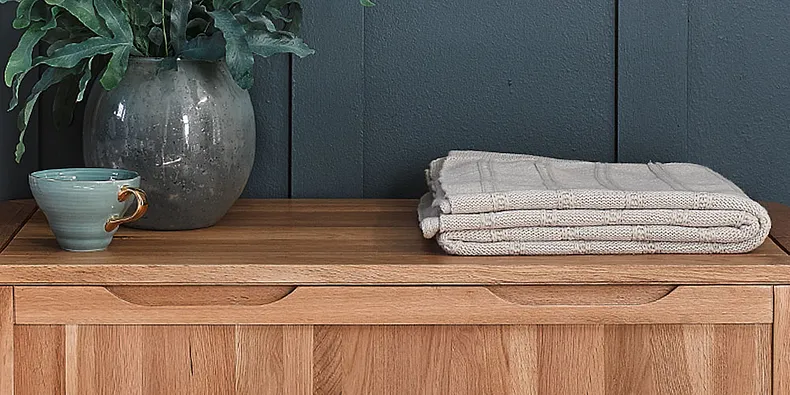Buy Furniture
What Makes Oak the Ideal Material for Quality Furniture?
Oak is hard to beat when it comes to furniture – here’s why
When it comes to furniture, most of us would agree that wood is hard to beat. With more character than metal and being easier on the environment than plastics, it’s easy to see why it is once again reverting to being the material of choice for so many things.
Of the varieties of woods available, oak has long held a special place in cultural heritages across the globe. A distinctive grain combined with an incredible longevity and utility make a material that is just as well suited to being used to make a children’s toy as it is a cooking utensil, furnishings or even grand building projects.
Little has changed. If anything, with the climate crisis and resource scarcity making more and more people conscious of the effects of our actions and usages, the case for sustainably managed wood has only increased and is likely to continue in the same vein.
So, what makes the oak the ‘King of Trees’? Read on to find out why the mighty Quercus is still the crowning glory of the arboreal world.
Durability and Strength
Not all trees are created equal, not even those from the same family. Having said that, considering there are around 600 members of the Quercus pack, variation should be expected. So, when we talk about oak with regards to its use in the building and furniture industries, we tend to be talking about a select group within the genus.
At around 720 kg/m3, varieties like the French ‘Quercus Petraea’ are classed as medium density hardwoods, but in spite of this, their strength and durability profiles surpass those of many of the other popular timber species with a higher density.
You needn’t go far to see this in action. Countless buildings using oak in their construction have been standing for centuries and look as good as ever, but there are examples that truly exist in the realms of awesome.
Greensted Church, situated in the Essex countryside, is the world’s oldest, according to research. It dates to between 998 and 1063 CE and is still structurally sound. That may be impressive, but even that pales in comparison to the oldest known wooden structure: a box-like frame found in the Czech Republic, reportedly 7,275 years old. The common link between these two disparate objects? They were both made of oak. (The fact that the Czech example is believed to have been part of the construction of a well attests to another aspect of its durability: its resistance to moisture.)
Aesthetics
Regardless of the way in which it’s aged – be it weathered by nature or preserved by treatment – few materials can match oak for its beauty. The elegant and distinctive highlights of its knot and grain texture sit on the rich, warm tones of the wood’s flesh in such a way that is comforting, charming and full of character – a feature that can be amplified if the timber is quarter-sawn.
As furniture, it is known to complement any stylistic leanings the décor may otherwise exude, which means you can spend your money on something knowing that it won’t look out of place if you ever have a decorative rethink in years to come.
Versatility
If you look at the sheer variety of the environments oaks have adapted to thrive in – let alone the shapes they grow into to suit – it would give some insight into its utility as a material for any number of processes. What begins life as soft and malleable grows to become tough and durable. All of these attributes can be exploited in its use as a material, making it one of the most adaptable and versatile, which is why it is seen as regularly in the foundations of buildings as it is in the furnishings of our homes.
Sustainability
One of the inevitable consequences of popularity is the potential for an industry to neglect their duty of care towards ethical practices in favour of meeting a rise in demand. Given the central position of deforestation in our collective consciousness’ fight for climate stability, the use of woods like oak have come under huge scrutiny, leading to great efforts being made in parts of the industry to ensure there is an infrastructure in place for renewable oak forests.
This is the main reason for the price of oak. It is considered a premium product due to its benefits first and foremost, but keeping the cost high also reduces its use, which in turn will hopefully ensure its legacy as a material for future generations too.
If you are thinking of using oak in your home, make sure that it is certified by a legitimate body, such as the FSC (Forest Stewardship Council) or PEFC (the Programme for the Endorsement of Forest Certification), which will put your mind at ease that your use isn’t contributing to irresponsible and harmful deforestation.
Environmental Ethics
In the sense that all use leaves a mark, it is debatable as to whether the term ‘environmentally friendly’ should ever be used to describe wood as a commodity, but, when viewed alongside the myriad dangers associated with plastics, for example, the label is more than understandable.
Trees spend their days absorbing carbon dioxide from the atmosphere and replacing it with oxygen. When it is cut, the carbon is locked inside the timber, meaning that it won’t get released into the atmosphere the way it would if it was burnt. So, in a way, each piece of oak furniture you have is a little carbon capsule, doing its bit for the climate. On top of that is the fact that the product itself takes very little processing or treatment, each of which will obviously contribute to a material’s environmental credentials.
The Planed and Simple Truth
Oak has assumed a significance that stretches beyond its use as a material, into the very genetics of cultures from across the globe. As we have seen, there are good reasons for this and it needn’t change: used responsibly, the things we use it for now will be enjoyed for years to come; kept sustainably, generations to follow will have the same privileges.

